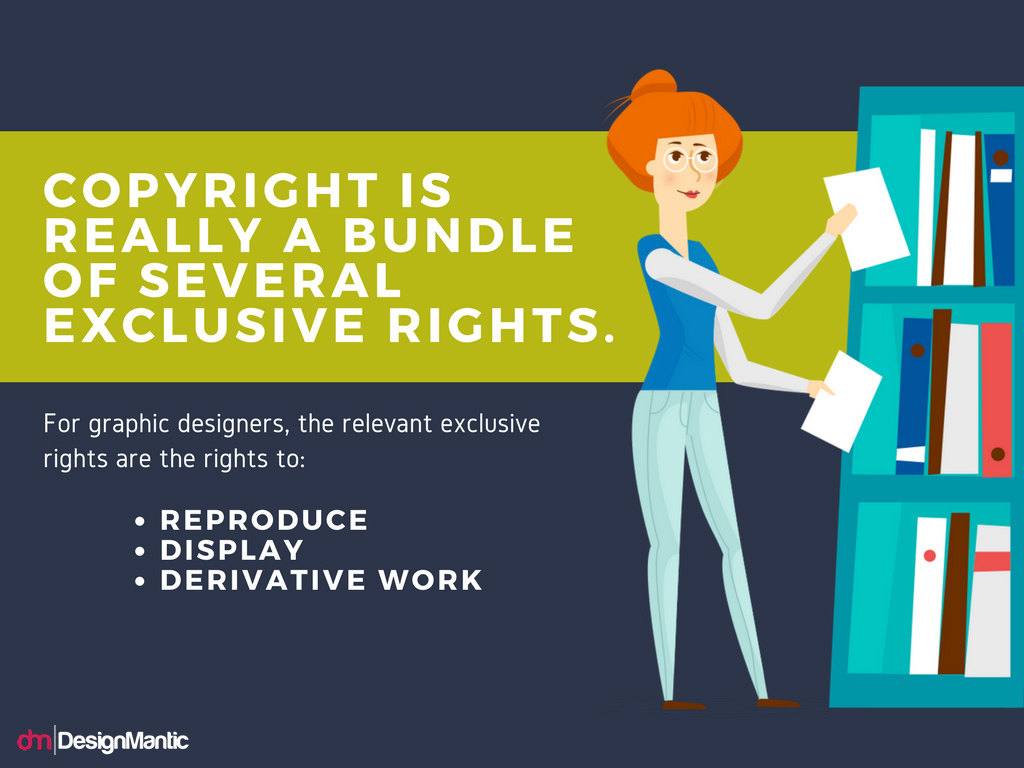Commissioned Graphic Design Do I Own It
This content has been reviewed and verified by Zaheer Dodhia, a logo and branding expert.
Imagine you buy a car from someone and the owner of the car refuses to transfer it on your name. Would you be comfortable with that? Of course not! You will want complete ownership of the vehicle since you are the one paying for it.
Now picture the same scenario between you (the designer) and your client. The client pays you hundreds of dollars to create a unique and professional logo that they can use to brand their business. Should he be concerned of the rightful ownership of the logo? Of course not! As long as he is paying you your hard earned fee, there is no reason why he shouldn't be getting legal ownership to the logo, right? No wonder, the love-hate relationship between designers and clients has been running rampant since time immemorial!
Why is Logo Ownership Important?
Before we move any further on who gets the ownership of a logo, let us first discuss its importance. Whether your design clients are finicky or intellectual, in the end ownership bears the following significance:
-
Freedom To Use It:
First and foremost, clients should have the freedom to use the logo they paid for. Of course, logo design is crucial for a brand's marketing. That is why a client needs to have complete ownership of the logo so that they can use it whenever and wherever they desire without fear of copyright violation.
-
Get Copyrights:
With proper ownership, the client can actually get his brand identity trademarked from their local registry dealing in Intellectual Property Rights. That way, the client will make sure that his business identity will not be infringed by anyone else.
-
Avoid Confrontation:
If the matter of logo ownership is not clear from start, there are chances that the client and designer will engage in untoward confrontation over it. This is something that no client would want, especially after paying for something.
Why designers don't give Ownership?
Recently, I also came across an interesting article on logo design ownership issue by Graham Smith where he rightly points out that
"logo designers are not making the practicalities of logo design ownership straightforward for their clients."
Which brings us to the all-important question…why designers avoid giving ownership to clients? Here are a few reasons I could think of why designers would do such a thing.
-
Too Possessive:
As a designer myself, I can understand how possessive we can get about our creations. Every logo we design, every concept we conceive is extremely valued to us. Mastering the art of crafting a memorable logo doesn't come easy and our work becomes all too precious for us. Maybe some designers become overly possessive about their designs and opt not to part ways with their design by not transferring ownership to the client.
-
Reuse it in Future:
Some designers like to take inspiration from their own past projects. Maybe this is why a few designers,who don't know the thin line between theft and inspiration,circumvent the topic of logo ownership with clients so that they might be able to reuse it in future. However, there is simply no justification for a designer to reuse previous logo designs in future projects. One can only go as far as use the client's logo for display purposes in their portfolio.
-
Hold for Ransom:
Believe it or not, some designers (mostly amateur) would evade telling the client about logo ownership in order to keep the 'upper hand'. As unethical as it sounds, it so happens that a few scrupulous designers would not clarify the ownership details in the proposal so that they can demand royalty when it is being used at various marketing platforms. What a shame!
Who Owns the Logo – Designer or Client?
Since design is crucial for business and brand, I believe that the logo design should be the property of the client once it has been passed on to him by the designer and the monetary transactions have been settled.
Moreover, regardless of who actually owns the logo design, it is the sole and moral responsibility of a designer to make the subject of ownership/copyright extremely clear to the client. Whatever terms and conditions you want be it just the license to use the logo or complete ownership, make sure to be crystal clear with your clients right from the word go. There is no point in dilly dallying on the subject and concealing the facts. Not only will it create confusion, it will also leave you looking like an unprofessional and dishonest person.

Illustration: iStock
We have requested some top-notch designers, such as Juri Zaech, Jacob Cass, David Airey, and Nicole Martinez, for their opinion on the matter and we will be updating the post once we hear back from them. Meanwhile, do comment and let us know what your take on the subject is. Do you believe that clients should get sole ownership of the logo design? Or should designers keep the copyrights to themselves? Comments please!
Update:
We are hearing back from logo designers and small business owners. Below are some of the replies.

"The logo process is a bit like giving someone a haircut… on a wig that they'll wear for a really long time. That's a really weird metaphor. But basically – a client pays you to create something for them, that defines their identity. Once they've accepted a haircut and left the salon wearing it on their head. it's theirs".
Based in Boston, Nicole Martinez is an Art Director specializing in illustrations and interactive design.

"I don't think theirs any debate. Client pays for the logo, so they should own it. I think it's fair that the designer use it in their portfolio, but that should be it. I think it's only amateur designers who refuse to pass over ownership, and people looking for a logo designer should see this as a warning sign."
Ian Paget is the Creative Director for Advansys Ltd. He also owns a design service, Logo Geek, based in Reading, Berkshire. Ian responded to our post on Google+.

"In my entire career I did not encounter a designer who would not pass the ownership on to the client, until today. A quick check of the terms and conditions of DesignMantic shows that they themselves do not give any of the ownership, despite this opinionated blog post. Specifically they formulate it like this:
"Customer understands that Company retains the rights to all designs and does not transfer any rights of the design to Customer. With respect to the Company Symbols, all ownership and intellectual property rights shall remain exclusively with Company. Company's ownership and intellectual property rights in Company Symbols are perpetual, and continue even after Customer purchases a design." (https://www.designmantic.com/terms_and_cond) In their request to me giving my opinion to the subject, they write about morals and responsibility. But to me all that sounds like hypocrisy. I would stay away from designers who do not grant the rights to the paying customer. And according to their blog post DesignMantic should agree. But then their terms and conditions say something different. What to believe? Better stay away."
Juri Zaech, a Swiss Art Designer, specializes in typographic projects. He responded to our request for feedback via email.
@Logo_Geek @designmantic i agree completely. logo rights belong to the client. a logo is a creative product designers need to let go of!
— PoseManikin (@PoseManikin) February 2, 201

The car ownership is a good metaphor but picture this… who is the real parent: mother or father?
Both would be the answer since without any of them the logo would not exist.
As in real parental duties, both have to do their best to preserve the child and make sure he or she will grow healthy and beautiful.
Nuno Alves is the Design Director at Usagi Design. He specializes in solving problems in the consumer market field. He offered his valuable opinion on LinkedIn.

I feel it depends on the contract/agreement/price you and the client set up. The price is determined by how much revenue the logo/brand will bring the client.
Based in Virginia, Vivian Marcoccio is the Graphic Design Coordinator at School of Continuing Studies, University of Richmond.

For me, logo ownership depends on the agreement with the specific client and whether the logo may have been designed for a business, educational facility, nonprofit organization, government agency, product or event. In setting up the project with a potential client, the predetermined options within are:
A. The client assumes full reproduction rights upon payment for completed project.
B. One time reproduction rights for the specified project, at the agreed fee, are granted to the client. Any other usage must be negotiated.
C. All reproduction rights on the copyrighted work are retained by the designer. The work may not be reproduced in any form without consent from the designer.
Of course, there's always room for negotiating – but everything is always defined within an agreement signed by both parties.
In any case, I do always retain some rights for myself. My project agreement specifies:
"The designer retains personal rights to use the completed project and any preliminary designs for the purpose of design competitions, future publications on design, educational purposes and the marketing of the designer's business. Where applicable the client will be given any necessary credit for usage of the project elements."
I've walked away from potential design projects when parties have not agreed to that last item in my agreement.
Jeff Fisher engineers innovative graphic identity solutions in helping businesses and organizations to get, and stay, on the right track. He is also a published author of design-related books, including Identity Crisis!: 50 Redesigns That Transformed Stale Identities Into Successful Brands and The Savvy Designer's Guide to Success.

Basically the designer was hired to design the brand/identity for the client. Once the client/customer pays for it, the client /customer is the rightful owner. The designer/creator
of the brand/identity is free to show it in their portfolio as examples of their professional creativity. This is their means of getting future business.
John Spiegel is the President/Design Consultant at graficSpiegel. He is a savvy designer with a strong mix of creative and business management and organization skills.

I've only designed one logo for a business that I kept the copyright to, and that was about 10 years ago. I will never do it again because there is so much rampant plagiarism going on these days.
Lets say you give the client exclusive rights to use the logo you designed, but you as the designer keep the copyright. Then, if someone comes along and decides that they want to lift the logo and use it, what happens then? Does that become your legal problem and expense because you own the copyright?
I think is makes way more sense to sell the full copyright and ownership of the logo to the client, and they can deal with any issues that come up after that. Plus, I'm not sure that very many companies these days will be up for not owning their corporate logo outright.
With over 15 years worth experience, Marco Echevarria has been helping businesses market their brands more effectively through custom identity designs and unique illustrations. He replied to us on LinkedIn.

"The designer/creator of the brand/identity is free to show it in their portfolio as examples of their professional creativity. This is their means of getting future business. "
Most often this is true if a designer is working independently of an agency or design firm, but it's not ALWAYS the case. I know of many cases with other designers, and have experienced a few myself over the last 35 years, where a designer is hired to create a logo design and specifically not permitted to even claim the work as their own – and certainly not allowed to show the design in a physical or online portfolio. That is why my contract has the clause it does. If working within an agency/design firm, the employee is sometimes forbidden to to exhibit the work as their own by the contract they have with an employer. I know of several designers receiving notifications from the attorneys of previous employers, demanding that design work, including logos, be removed immediately from online portfolios. I recommend that any designer going into an employment situation have a good understanding of the rights/permissions issues before accepting a job. The ability to share the work one has created is not always a given these days.
Retaining partial ownership of logo designs has actually been of help to me in regards to the issue of plagiarism. With over 300 of my designs having been ripped off in just the last 2.5 years by designers who apparently don't know when to draw the line between inspiration and imitation, I am often notified of infringements from design peers familiar with my work. I have it down to such a system now that I can often deal with the issue without having to involve my clients. In some cases, my client and I – working together – have been able to "double team" infringers quickly to a satisfactory resolution.

With my work in over 180 design books at this point, maintaining reproduction rights has been very helpful in being able to submit work for publication – without having to go back to my client time and time again for specific permission. When a newspaper, magazine, online resource or educator contacts me asking for permission to include/share my work I have the ability to do so legally with my signed project agreements. Publication in books, magazines and elsewhere has also been helpful in dealing with plagiarism situations. In one instance, a company was going on and on about how they could not have possibly ripped-off my logo design, because theirs was created in 2000. When I was able to share that my logo had been published in a 1994 book, they were singing a different tune.
Of course, in my own situation, it has been helpful that my husband has been in the legal industry for almost 20 years. A lot of excellent legal advice is available to me at the "friends and family" rate.
The client owns the rights to the FiNAL logo choice. I retain the right to the variations not chosen and state that in my contract. WE as designers are being paid to create an identity for a client. The logo is just like raising children…
raise them to have wings and then let then fly away to have their own identity!!
Dyan Sutton is a Branding Specialist and Owner of Creative Idea Matter, she specializes in creating visual messages that spark emotion and ignite brand conversation. She tweets at @dyansutton.

My contract states the ownership/copyright of the logo doesn't transfer to the client until the design has been paid for in full. Up until then I retain ownership. Once they've paid, it is all theirs. Like Dyan, any rejected concepts I retain copyright to. It is simple business. If I catch them using a logo concept they have not paid for, I bill them for every unauthorized use of the logo I can find.
Patricia Schaefer is a Graphic Artist based in Dallas. She runs Contemporary Native, a commercial design firm, and teaches secondary/college level Arts.

That's interesting. Here in Germany (the country of rules and regulations 😉 ) things are different. The Designer always (by law) stays the "owner" of a logo. I as a designer couldn't change that, even if I wanted to, because I am the "Urheber" (originator, author) and will always be. So I will always have to negotiate with the client. Usually I give the unlimited or exclusive rights of use "away" to the client which makes him a de-facto owner. But of course I will always keep the right to show my work in a portfolio as an example of my professional creativity.
Thomas Seifert is a brand identity consultant and CEO of TOMCOM. He replied to our post on LinkedIn.

The author/designer has all rights and gives license to the client. If the client wants to change the logo or use it for a bigger or different company he should ask permission. Which is of course preferable as designer.
Nicole E. Zonderhuis is a creative and passionate brand strategist and designer at Webcraft, creative design agency in Utrecht, Netherlands. She is an active LinkedIn Fellow and you can find her profile here.

I think the word "ownership" is misleading in this (german) case.In germany (and probably in Holland) you can own a piece of paper with the logo printed on. But you can not own the logo itself because it's nothing material. It is an Idea or a creation. Same thing with written word. You can own the book but not what's written inside. For those who are interested, you can find an explanation here:
Maybe this will answer your Question (Quotes from Wikipedia):
"The Urhebergesetz is an authors' right ("droit d'auteur") or "monistic" style law. As such there is a special emphasis on the relation between the work and its actual author.[3] The right is perceived as an aspect of the author's general personality right and as a general rule is therefore inalienable. This also means that there is no corporate copyright in Germany[4] and the fundamental rights cannot be transferred except by heritage."
and
"While exclusive licences are almost as powerful as copyright transfer, the author always retains some rights to the work, including the right to prevent defacing and to be identified as the author.[6] Employment agreements are frequently construed as granting the employer an exclusive licence to any works created by the employee within the scope of his obligations."
Regarding the client this means that all that matters is the "right of use", which is regulated by a contract. If your client wants the exclusive right of use and you give it to him, he's the only one who has the right to use the logo. That excludes even you as the Designer. But if necessary, he has to mention your Name as creator / author.

Very interesting discussion with great points and a global perspective. I had always assumed – right or wrong – that the 'logo' belonged to the designer (or their 'employer') until it was paid for in full, but the design still had a residual right to use the same in their 'portfolio' for their self marketing purposes.
That seems to be the easy part.
However logos and identities are not an end in themselves. If they are managed well, they become a part of the clients success business. Clients invest huge resources turning them into visual idents for brands, products and services – with huge emotional (and financial) implications both for the client and their customers. Businesses grow and shrink, merge and get involved in new areas of operations. A start-up (say What-an-app!) worth nothing a few years back, grows into a multibillion success story.
Does the designer hang around hoping to get a windfall too? If so, how would you 'charge'?
What does the 'client' really pay for?
Victor Otieno is an aspiring creative with an appreciation for good strategy and love for Africa and the environment. He is the owner of Pure Design Limited and responded to our discussion on LinkedIn.

As the client has commissioned the designer to create a logo or corporate image, on payment, the logo and image belong to the client. If it is not paid for, the copyright belongs to the designer.

LEGALLY, the original creator of any piece of art, which includes logos, owns all copyrights to the art. The client owns the logo, ONLY after the artist signs over all rights to the logo to them.
In order to assure our clients that they will own their logos, we put in our contract that once their bill is paid we will sign over ownership of the logo to them. If we did not put that in our contracts we would retain ownership.
A logo is no different than a photograph. You normally hire a photographer to shoot a photo. They charge you to use the photo, but you have to pay considerably more to own it. If you are an salaried employee, then the company you work for immediately owns the art.

Interesting comments from everybody. Why don't we have some legal friends to make recommendations here? Different countries have different laws to govern the logo and CI copyrights. In Hong Kong, we pretty much follow U.S. and U.K. rules and regulations, designers (or freelance) think everything they created is owned by the clients or the agencies. In most of the design schools in Hong Kong, they rarely teach or even address the legal side of design or creativity. Eventually, they will either give up or ignore the issues. I always told my design students in the past that all legal documents related to their creative work should be signed and agreed by both parties, the designer and the client. However, most of the designers in the world don't know how to protect themselves from the beginning and are not aware of the Copyright Law & Its Generalities. They will see filing legal documents to be the least of their priorities. So, they will continue to create without protecting themselves from lawsuits.

It really depends on the Terms & Conditions that are agreed at the start of any project.
Typically, T&Cs in the UK would likely grant license of use to the client, not ownership.
Even when agreeing to do work for foreign clients a good set of T&Cs will state that the agreement comes under UK law (or the respective law of the location of the designer). This prevents any dispute on under whose law any dispute should be judged against.
If you are a designer and do not issue T&Cs at the start of a project you will be exposing yourself or your business to possible disputes that need resolving through litigation.

Commissioned Graphic Design Do I Own It
Source: https://www.designmantic.com/blog/who-owns-the-logo/
0 Response to "Commissioned Graphic Design Do I Own It"
Post a Comment